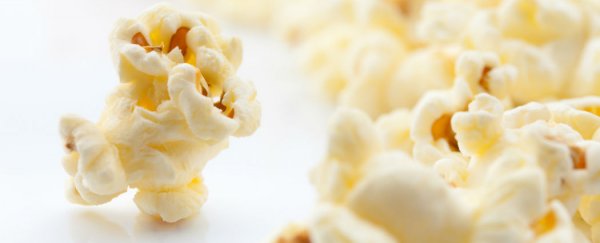You know you're on to some comedy gold when a paper opens with the line: "Popcorn is the funniest corn to cook, because it jumps and makes a 'pop' sound in our pans." Yep, okay. No arguments there. I'd even go so far as to say that it's the ONLY funny corn to cook. There's nothing funny about throwing an ear of regular corn on the grill, and glass gem corn sure looks pretty, but it'd actually be pretty sad to drop all that beauty into a vat of boiling water.
So popcorn is hilarious, that much we've established. But how exactly does it work? French physicists Emmanuel Virot and Alexandre Ponomarenko from the École Polytechnique decided to investigate.
The everta variety of corn (Zea mays) is the only one capable of becoming popcorn, because it has a far more compact shell than the rest of the corn varieties. So the team got some microwavable Zea mays everta together, put them on the hot plate, and turned the heat up in gradual increments while filming the whole thing on a high-speed camera.
Capturing footage at 2,900 frames per second, the scientists watched as just 34 percent of the kernels would pop at 170 degrees Celsius, but once the temperature hit 180 degrees, they all went crazy - 96 percent of them forced their fluffy white guts out of their golden hulls like good popcorns. "We found that the critical temperature is about 180 degrees Celsius, regardless of the size or shape of the grain," Virot told the AFP news agency.
But why? Virot and Ponomarenko explain in their paper, published in the Journal of the Royal Society Interface:
"When the popcorn temperature exceeds 100°C, its water content (moisture) boils and reaches a thermodynamic equilibrium at the vapour pressure, as in a pressure cooker. Above a critical vapour pressure, the hull breaks.
At the same time in the popcorn endosperm, the starch granules expand adiabatically [which means heat is reduced through a change in air pressure caused by volume expansion] and form a spongy flake of various shapes. Then, the popcorn jumps a few millimetres high to several centimetres high and a characteristic 'pop' sound is emitted. To the best of our knowledge, the physical origin of these observations remains elusive in the literature."
Two odd things here. The first, each kernel of corn contains a combination of water and starch - the best kernels have between 13 and 14.5 percent moisture. When the kernel is heated up, the water is converted to super-hot steam, which liquifies the starch. So a fraction of a second before you get popcorn, you have a gooey starch mess, which means the process of making corn is strangely similar to that of caterpillar-to-butterfly metamorphosis.
Anyway, once the pressure has been built to a critical point, the liquid starch bursts through the hull and cools down hyper-fast into a solid. That's why no popcorn shape is the same, and when you look at the surface through a microscope, (which you can see in the video below), you'll find it's made up of lots of tiny, solidified starch bubbles. But herein lies the other strange thing about popcorn - that 'popping' sound doesn't actually occur when the kernel explodes open to release the starch.
Tia Ghose explains at LiveScience:
"By looking at the footage and using a microphone to capture the pops, the team found that the pop sounds didn't happen when the hull first split. Instead, the pop seemed to occur when water vapour inside the kernel was released, creating empty cavities inside the popcorn kernel that resonated once the pressure dropped. Similar phenomena occur when volcanoes or champagne corks pop."
So the liquid starch has broken through the hull and changed into a solid - all in the course of a few hundredths of a second. And here's where the weirdness continues. The scientists say the newly formed popcorn uses a 'starch leg' to propel itself from the ground, just like a human gymnast. "As a result, popcorn is midway between two categories of moving systems: explosive plants using fracture mechanisms and jumping animals using muscles." Amazing. Here's the comparison:
 Credit: Virot and Ponomarenko
Credit: Virot and Ponomarenko
So now the real question is how can we avoid having all those unpopped kernels at the bottom of the bowl? The unfortunate answer is, well, you can't. Virot told LiveScience that the unpopped kernels likely have defective hulls, which prevent high pressures from building inside. And if you've left a kernel sitting too long in the bottom of the pan, you could actually burn a hole through the hull, which means it's your fault that there's nowhere for the pressure to build.
For more popcorn insights, here's NPR's Skunk Bear:
Source: LiveScience
